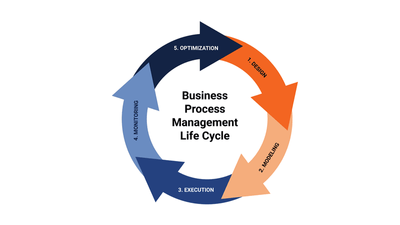Business Process Management and the five steps in the BPM lifecycle
Written by Silvia Settomini
15 April 2022 · 8 min read

Every organization, regardless of the level of complexity, consists of different business processes. From a small grocery shop to an international financial services company, they both rely on processes to function. For example, how to handle purchase requests, warehouse management, loan origination procedures, and new employees onboarding. They are all processes.
Whether formalized or not, business processes can be defined as a sequence of repetitive activities - involving multiple departments and systems, that contributes to the overall business goal. As stated in our previous blog post on business process modeling, we can say that a business is only as efficient as its processes.
Hence, it looks obvious that if they’re not accurately organized, business processes can affect the entire organization’s efficiency. Even the smallest error, if perpetuated, can lead to a much larger lack of performance.
That’s why Business Process Management is essential.
What is BPM?
Defining Business Process Management (BPM) is a challenging task, as there's no universally accepted definition. But, if we had to choose one, the Association of Business Process Management Professionals (ABPMP) had a go at it in 2009. According to them, BPM entails a range of activities, including identifying, designing, executing, documenting, measuring, monitoring, controlling, and promoting improvements in an organization's processes. Essentially, it's about effectively achieving business goals.
BPM can help you oversee how work is performed in your organization to ensure consistent outcomes and take advantage of improvement opportunities - for example, reducing costs, execution times, or error rates. Though often considered a discipline for big companies, BPM can actually provide remarkable benefits to every business, no matter the size - for example:
- gain control of every process;
- make the everyday activity more efficient;
- identify and solve bottlenecks and frictions;
- provide employees with the bigger picture;
- evaluate both individual and overall performance.
Overall, BPM implies a long-term organizational commitment to managing processes. It follows a lifecycle model with well-defined steps, helping you establish a managerial practice that promotes continuous process improvement in your organization and aligns its processes with strategic goals.
Types of Business Process Management
Business Process Management involves the use of various approaches and methodologies to managing and optimizing business processes. Hence, there are different types of BPM based on what the focus, goal, or method is. Those types aren’t mutually exclusive, and you can adopt a combination of approaches based on your organization’s needs and objectives.
The traditional and most renowned types of BPM are as follows:
- Integration-centric BPM - it focuses on integrating different systems, applications, and data to streamline and optimize business processes. It can help you automate tasks and improve the flow of information. Integration-centric BPM is often seen as a key enabler for digital transformation initiatives.
- Document-centric BPM - this approach focuses on managing and optimizing business processes by centralizing and automating document-centric activities. It can help you streamline operations, reduce manual intervention, and improve overall process efficiency. Document-centric BPM is particularly valuable in areas where document handling is critical to the workflow - for example, contract management and claims processing.
- Human-centric BPM - this approach prioritizes the human element in the design, execution, and optimization of business processes. It recognizes the importance of human interactions, decisions, and collaboration within processes and aims to enhance the overall user experience.
Besides these three approaches, there are many other types of Business Process Management - for instance:
- Model-driven BPM - it offers a structured and visual approach to process management. Its focus is on creating and using process models that guide the design, execution, and optimization of business processes. Thus, process changes are made at the model level and then applied to the actual processes. This approach is especially valuable in complex business environments, such as public administration, where a clear understanding of processes is crucial for success.
- Low-code / no-code BPM - it’s an approach that leverages platforms, allowing users with varying technical skills to participate in the development and modification of business processes. These platforms provide visual, drag-and-drop interfaces and pre-built components to streamline the creation of applications and process workflows.
BPM lifecycle
Business Process Management allows to systematically and constantly improve company processes. It’s generally represented as a cycle of five different phases and actions that are repeated over and over again, in a non-strict order, to get continuous improvement.
Let’s explore these five stages in detail and the objective of each of them.

1. Design
The first step of the BPM lifecycle is the design. The main goal of this stage is to understand how the business process works, what the resources involved are, including both employees and tools, and what the desired outcome is. Gaining an in-depth understanding of the business process is the first essential step to identify bottlenecks and areas for improvement.
Collecting information is key in this phase. From the way the process starts (what inputs) to how it ends (what outcomes), you should identify each task’s responsibility, systems integrations, and the business rules behind it.
2. Model
Once you have identified and understood the process, you need to represent it in a way that all people involved can clearly visualize it. Here comes the second step of the BPM lifecycle: modeling.
In this stage, you draw how things are currently done: the so-called as-is version of the process. Modeling a process allows you to spot inefficiencies and bottlenecks that you can improve. This leads to a second version of the model, called the to-be process, where the necessary improvements are modeled. You may be able to model the to-be process from the very beginning or you may first need to monitor the as-is version. No matter how many steps and cycles you need, being able to directly compare the two models is essential to inform other stakeholders about the new improvements and agree upon them.
When modeling business processes, relying on a standard can really make the difference. The most widely used standard is Business Process Model and Notation (BPMN), which provides a series of elements that help represent even the most complex process. BPMN essentially serves the main modeling purpose: making the process readable and understandable by everyone. You can also decide to take it a step further and visualize the operational decisions and relative KPIs. You can do so by using the Decision Model and Notation (DMN) standard. If you want to know more about the benefits of combining process and decision modeling, read the blog post on modeling business decisions by Cardanit Product Manager.
3. Execute
The third step of the BPM lifecycle turns diagrams into practice. It’s the execution phase, which can be either manual or assisted by a BPMN engine, or both.
For complex processes, in which the proposed improvements can be very expensive in terms of both cost and effort, the good practice suggests first executing it within a small group of people. This way you can evaluate the impact and assess the effectiveness before implementing it on a larger scale.
Trial and error, even if starting within a testing environment and although often necessary, can also be risky and expensive. In these cases, Process Simulation can take this phase one step further.
4. Monitor
So, you understood how the business process works and where the bottlenecks are. You put it on a clear BPMN workflow diagram and drew the possible improvements. Then you executed the process. Now, how can you determine that the proposed changes are actually working?
Let’s turn to the man who invented modern business management: Peter Drucker. As he said, “if you can’t measure it, you can’t improve it”. This assumption highlights the importance of the fourth step of the BPM lifecycle: monitoring.
In this phase, you monitor and review the process in real-time. You set KPIs and get tangible insights to evaluate the performance of the process and the effectiveness of the implemented changes. Are the bottlenecks resolved and the delays and mistakes adjusted? Are all resources working smoothly and efficiently? You can answer all these questions by performing monitoring and analysis.
5. Optimize
The information gained from the monitoring phase allows you to know if the to-be process is actually giving the expected results. In the last step of the BPM lifecycle, you optimize the process to find ways to improve it further and enable the organization to work more efficiently.
As said above, processes are by definition repetitive, and continuously implementing even small improvements can really affect the overall performance.
In the optimization phase you see the bigger picture, analyze the results, and suggest further changes to the process.
For the BPM lifecycle to be truly successful, you need to approach it with a continuous improvement mindset.
For the BPM lifecycle to be truly successful, you can’t stop after the optimization stage. You need to start over again to ensure continuous business process improvement. Just like business processes are repetitive, so should the BPM lifecycle steps.
BPM documentation
BPM documentation is a critical component of your BPM initiatives as it’s essential for understanding, analyzing, designing, improving, and managing the business processes within your organization. It includes a comprehensive set of documents and records created and maintained during the BPM lifecycle - for example:
- process maps, flowcharts, and descriptions;
- an outline of the roles and responsibilities of all individuals involved in each process;
- business rules and decision logic embedded within the process;
- data flows within and between processes, as well as integration points with other systems;
- a process performance analysis outlining bottlenecks, cycle times, and areas for improvement;
- version control records detailing the version history of process documentation.
Overall, BPM documentation provides a foundation for continuous improvement, knowledge sharing, and organizational alignment. Its regular review and update is crucial to ensuring its relevance and usefulness over time.
Modeling business processes with Cardanit
Although you may need to skip one or more of the steps described above, it’s clear that the modeling phase plays a key role to improve your business process. Being able to clearly visualize the process lays the basis for any improvement. In such a scenario, relying on a BPM software like Cardanit can really make this step easier.
Based on the BPMN and DMN standards, Cardanit helps you map from the simplest to the most complex process, making the modeling phase very smooth. You can focus on the most important aspects, rather than on the design part. For example, what the tasks' sequence is, what departments and systems are involved, if and where there are any frictions.
In addition, you can generate a comprehensive report, outlining your process model in detail. You can also easily share the report with all stakeholders, so they can all agree upon the different versions of the process and see how their work can change and be more efficient.
In conclusion
Business Process Management is a discipline that uses various tools and methods to design, model, execute, monitor, and optimize business processes. It’s through BPM that organizations can create, analyze and improve their business processes in order to increase the overall efficiency.
In this blog post, we explored the basics of Business Process Management, covering its definition, types, documentation, and the crucial steps within the BPM lifecycle. We also highlighted how our BPMN modeler Cardanit can help you by providing a user-friendly interface for modeling processes, collaborative features, and efficient documentation capabilities.
Further reading
Improving services by modeling business processes in public administration
Modeling supply chain management processes with BPMN


Silvia Settomini is a Marketing Specialist at ESTECO, the mother company of Cardanit. With an interest in the BPM market, she collaborates on marketing and communication activities for Cardanit.
Silvia Settomini is a Marketing Specialist at ESTECO, the mother company of Cardanit. With an interest in the BPM market, she collaborates on marketing and communication activities for Cardanit.
Learn what key features and ingredients your BPMN editor should have to ensure a smooth and efficient business process mapping experience.
Key ingredients for efficient process mapping
Learn what key features and ingredients your BPMN editor should have to ensure a smooth and efficient business process mapping experience.
Key ingredients for efficient process mapping
Learn what key features and ingredients your BPMN editor should have to ensure a smooth and efficient business process mapping experience.
